Growing Asparagus in Edmonds
Asparagus can be fairly expensive at the supermarket, but, when growing your own, it is quite easy to tend after the initial planting. As a perennial vegetable -- plant once, harvest for years -- asparagus planted in a well-maintained bed can provide you with sweet, slender spears for 15 years (can produce up to 20-30 years!). In addition, its vibrant, ferny foliage makes an excellent feathery, graceful ornamental.
 My asparagus adventure derived from an impulse purchase I made at Sky Nursery when I purchased 3 groups of 5 crowns. My thought was “Some Asparagus would be nice!” with no thought whatsoever where I would plant them. The crowns I purchased were already two years old and the three varieties were:
My asparagus adventure derived from an impulse purchase I made at Sky Nursery when I purchased 3 groups of 5 crowns. My thought was “Some Asparagus would be nice!” with no thought whatsoever where I would plant them. The crowns I purchased were already two years old and the three varieties were:
- Jersey Knight- This all-male series of hybrid asparagus varieties is a hardy plant that performs well in chilly climates and one of the more vigorous types of asparagus; highly resistant to asparagus diseases such as crown rot, rust, and fusarium wilt. Does well in heavier soils and will not seed new plants. Longer lived than Mary Washington.
- Sweet Purple- Unique, deep-burgundy asparagus is a rare kind and was first developed in Italy. It
 has a unique characteristic feature: the presence of anthocyanins, which gives the plant its purple color. This type of asparagus has 20% more sugar content than the rest of the asparagus species and can be eaten raw! This is why it is very sweet and has a nutty flavor. Spears are generally larger than green types and more tender and less stringy.
has a unique characteristic feature: the presence of anthocyanins, which gives the plant its purple color. This type of asparagus has 20% more sugar content than the rest of the asparagus species and can be eaten raw! This is why it is very sweet and has a nutty flavor. Spears are generally larger than green types and more tender and less stringy. - Mary Washington- is a traditional variety that produces long, strong, deep green spears with pale purple tips. Resistant to rust. Appreciated for its uniform size and delicious flavor, ‘Mary Washington’ has been a favorite of American gardeners for more than a century.
My dad grew up in Iowa where asparagus grows wild in many ditches, and if you know where to look, they could be harvested early each spring. They made a mental note of locations of asparagus in the fall when the plants are large and noticeable after they turn golden. Sometimes the brushy tops were still visible in the spring. He had always yearned to grow them in our garden of my childhood but never did get around to it. Come along with me in my journey creating a bed of asparagus that would make my father proud!
Asparagus plants are tall and take up a lot of space.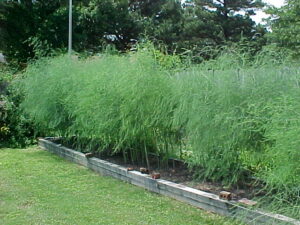
My first challenge was the location. Asparagus takes up a fair amount of garden space, and being a perennial vegetable, it will be in the same spot for years, and it's important to find a spot where it will have all the growing conditions it needs. Asparagus plants are slow to mature, taking three to five years to really fill in and mature, but it's worth the wait. Once they start hitting their stride, you will be harvesting asparagus spears for more than a month every spring. I did not want to monopolize our raised garden beds so I settled on the east side of our house where there was a 2-foot wide by 50-foot long area topped with mulch where nothing was growing against the house. Since they will be growing against the side of the house, I won’t have to worry about the tall plants blocking the sun to any other plants.
Light Requirements.
My second challenge was the amount of sunlight that area receives. Asparagus thrives in full sun, but it will tolerate shade for part of the day as long as it gets at least 6-8 hours of light. Asparagus prefers cooler weather, so in warmer climates, planting in the shade will protect it from the hot summer sun. Position your asparagus preferably so that it has partial shade in the hottest afternoon sun. In my situation, the east side of the house is in shade in the afternoon. Although not optimal, the asparagus will have around 7 hours of sun but not be exposed to the afternoon sun.
Soil Conditions.
Asparagus needs well-drained soil. The soil against the house is solid clay about 3 inches down, so I added soil with a bit more sand and mulch. Amend the soil's acidity, if necessary, to a pH between 6.5 and 7.5. To raise acidity, apply sulfur or aluminum sulfate. To lower acidity, use wood ashes or pulverized limestone. The soil must drain well so the plants are never sitting in water.
Soil Preparation.
It is recommended to dig a trench 6-12 inches deep. I dug mine about 10 inches deep as I had seen that as the most common recommendation. I used the extra couple of inches to add in more compost and amended soil to make up for the hard clay soil underneath. The compost I used was from my own compost bin and, as you can see in the photo above, had a high concentration of earthworms! A mounded-up row with normal dirt is commonly added on top to support the crowns and spreading the roots out like a spider on each side. I chose instead to create individual mounds so that I could splay the roots out on all sides of the mound and not on just each side of the row. Another challenge I faced was the irrigation pipes about 8” down. I took advantage of the pipes as the support for the crowns and put the compost on each side of the pipes. The crowns should be about 4-6” below the soil line. Amend the site with 10 to 20 pounds of bonemeal or composted manure per 100 square feet of soil. This adds an organic source of nitrogen and phosphorus. It is also recommended to mix a 2-inch layer of potassium-rich compost into the soil before planting asparagus. Banana peels, granite dust, and wood ash contain high amounts of potassium. Our compost bin processes a lot of banana peels from our kitchen so I relied on our compost to supply the potassium.
How far apart to plant asparagus?
In my research, I found a recommended distance ranging from 8” to 18” apart. The most common recommendation was 18” apart although the instructions I grabbed from Sky Nursery when I bought the asparagus stated 12” apart. When planting rows, plant them 18” apart . I went with 18” between the crowns simply because it worked out well for the east side of the house and how the 15 plants I had fit in the available space. Asparagus roots must be soaked for several hours prior to planting. The crowns are placed on top of the dirt mounds, the roots are spread out on all sides of the mound.
Covering up and filling in the trench
It is recommended to use a fertilizer that is 5-10-10 or 8-24-24. However, I used E.B. Stone Organics all-purpose plant food because it also contains humic acids and soil microbes along with blood meal, chicken manure, bat guano, alfalfa meal, bone meal, feather meal, kelp meal, and potassium sulfate. After applying a layer of fertilizer, I added back in soil mixed with E.B. Stone Planting Compost and watered the plants well. As shoots appear, I will add more soil to fill the trench until it's ultimately filled and flush with the soil line.
Weed Control
Remove weeds when preparing the bed, and keep weeding by hand while the asparagus plants are young. Don't use a hoe or other tool because the roots can be damaged. Asparagus roots form a tightly woven mat, from which it is challenging to remove weeds. Add mulch to the asparagus bed to control weeds. Do not add any other plants to the asparagus bed—they dislike any competition for nutrients. Apply a 3- to 4-inch layer of straw mulch up to three times during the active growing season. Grass clippings also make an effective and inexpensive mulch.
Using salt in the soil for asparagus myth
Because asparagus is salt resistant, gardeners have used salt to kill weeds around asparagus plants. Salt does kill weeds and other plants by pulling water out of the plant. It is also drawn into the plant when the soil is wet. Once inside the plant, it prevents the plant from moving water to other parts of the plant. Essentially the plant dies of dehydration. While asparagus can resist salt, it is not immune. Contrary to popular myth, asparagus does NOT need soil amended with salt.
Watering Asparagus
Asparagus needs regular watering, especially while young; give it 1 to 2 inches of water per week during its first two growing seasons; give older plants about 1 inch per week. If you give them a good start when you first plant them, and you'll have fewer problems in future years. Consider adding drip irrigation or a soaker hose to the asparagus bed.
The asparagus bed against the house is right at the edge of the yard where my current irrigation system is located watering the grass with a 180-degree adjustable spray. Rather than running drip irrigation, I may adjust the spray pattern to 190 to 200 degrees to also supply water to the asparagus.
Harvesting Asparagus
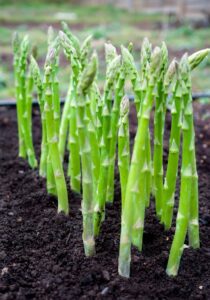 Harvest every two to four days by removing 7 to 9 inch-long spears with a sharp knife. Stop harvesting when the diameter of the spears is less than 3/8 inch.
Harvest every two to four days by removing 7 to 9 inch-long spears with a sharp knife. Stop harvesting when the diameter of the spears is less than 3/8 inch.
Harvest asparagus no sooner than two years after planting the crowns. This gives the plants time to form healthy root systems.
In the third year, begin harvesting spears that are 5 to 7 inches long before the tip becomes loose (diameter doesn't matter). You can either snap off the spears or cut them with a knife just above the soil line. If you use a knife, be careful you don't also slice the later shoots that are still underground and haven't yet poked through. Your harvest time can extend to three weeks.
Harvest for about four to six weeks in the fourth year. In subsequent years, the shoots will continue emerging from the soil throughout the spring. After you've been harvesting for more than a month and the weather starts to warm, the shoots will begin to get spindly. At this point, allow the plants to grow into their mature, ferny foliage, which will feed the roots for next year's crop. Asparagus plants can continue producing for up to 20 to 30 years and can be divided or transplanted if they become overcrowded or could benefit from a move.
If spears become progressively smaller, cut back on the harvest time in spring and fall to boost plant vigor. However, if spring and fall spears grow progressively larger, increase your harvest time each season.
Overwintering
Cut back asparagus ferns when they turn yellow after your area's first frost.. Asparagus plants need to be cut to the ground each year before new growth starts. You can do this in late winter or fall. Removing the dead foliage in the fall offers the advantage of preventing problems, like asparagus beetles, from over-wintering in them. However, some gardeners like to leave the foliage for winter interest.
Male Plants
Asparagus is either male or female. Most gardeners plant primarily male plants, which produce larger spears in greater numbers. This is because female plants expend tremendous energy producing seeds and small, weedy seedlings that compete with established asparagus plants. Until the last two decades, types of asparagus consisted of a mix of male and female plants. However, researchers have discovered ways to effectively propagate all-male varieties of asparagus. Look for all-male plants for plenty of big, flavorful spears.
Health benefits of asparagus
One of the reasons asparagus is such a healthy vegetable is that it contains several vitamins and other nutrients while delivering a minimal number of calories. Asparagus is one of the best foods available for meeting the recommended daily intake (RDI) of vitamin K and folate, providing 57% and 34%, respectively. A half-cup of plain, cooked asparagus contains between 20 and 40 calories, 4 grams of carbohydrates, 2.2 grams of protein, 1.8 grams of fiber, and zero sodium. It also provides 6% of the RDI of potassium, 5% of phosphorus, 18% of vitamin A, 12% of vitamin C, 7% of vitamin E.
Asparagus is considered a wonder food for good reasons. A few of the many health benefits are that asparagus is good for eyes, skin, immune system, blood clotting, digestion, weight loss, lowering blood pressure, fighting cancer, brain-boosting, preventing UTIs, bone strength, and even treating hangovers and lowering the risk of depression. To learn more go to WebMD and 36 Amazing Health & Beauty Benefits Of Asparagus.
Get your asparagus planted now! A good rule of thumb is to plant 25 asparagus plants for a family of four. You may want more if you plan to freeze some for the winter.
Do you have any other tips for growing asparagus in Edmonds? Other interesting information? Let us know in the comments below!

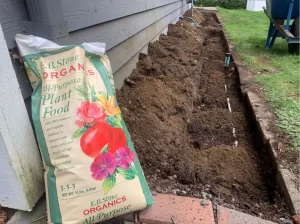

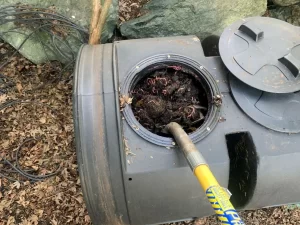

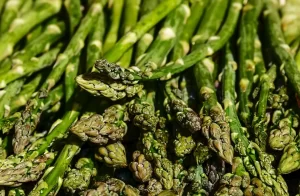

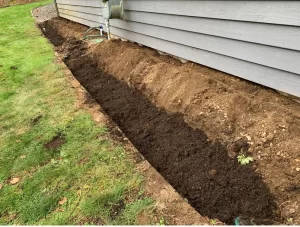
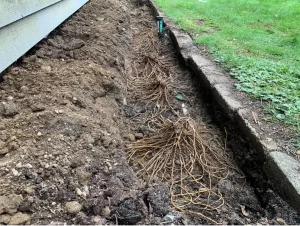






Nearly 5000 acres of asparagus are grown in Washington State. Most of it is grown on 100 family farms within sixty miles of Pasco and worth about $22 million to Washington’s economy.
An asparagus spear can grow 7 to 9 inches in one day. The warmer the weather, the faster it grows.
The fresher it is, the tastier it is but it stores well, too. Asparagus is very thirsty and likes wet feet. Store stalks upright in a bowl or dish with an inch of water. No room to stand it up? Wrap the cut ends in a moist paper towel, cover with plastic and refrigerate.
The history of Asparagus goes back to being depicted on Egyptian wall art as early as 3000 BC. The word derives from the Greek word “asparagos,” which means “to spring up.” Ancient Greeks ate wild asparagus but it was the Romans that started cultivating it over 2000 years ago. It was alleged that Julius Caesar ate asparagus with melted butter and it was dried for use in the winter. The Romans are said to have frozen asparagus in the Alps for the feast of Epicurus.
The oldest surviving book of recipes is said to be Apicius’s “De re coquinaria” from first century AD and contains a recipe for cooking asparagus.
Below is the link to the 2000-year-old recipe if you would like to try it!
https://followinghadrian.com/2013/05/07/a-taste-of-ancient-rome-aliter-patina-de-asparagis-omelette-with-asparagus-and-fresh-herbs/
There is a lot of good information in this article. I remember digging asparagus out of the ditches where it was growing wild in Fonda. I guess the seeds came from birds ?? I have been eating it raw out of my garden this past week.
Asparagus – one of my favorite veggies. Lots of fond memories of my grandma’s asparagus patch in Spokane. Good to know it’s possible to grow it in our area. Nice article with thorough information from your own backyard experience. Thanks!